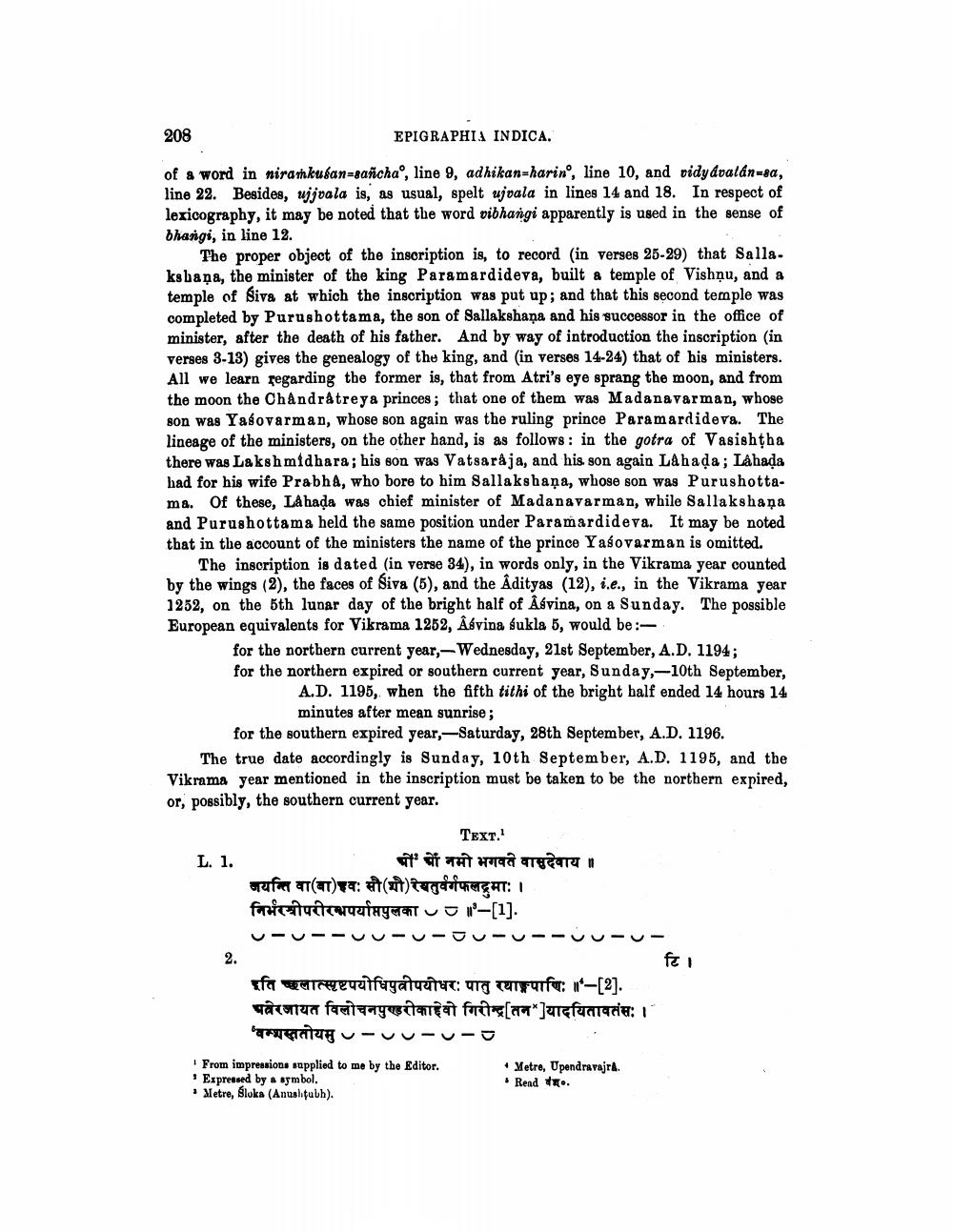________________
208
EPIGRAPHIA INDICA.
of a word in niramkuban=sañcha, line 9, adhikan=harin", line 10, and vidy dvalán=sa, line 22. Besides, ujjvala is, as usual, spelt ujvala in lines 14 and 18. In respect of lexicography, it may be noted that the word vibhangi apparently is used in the sense of bhangi, in line 12.
The proper object of the inscription is, to record (in verses 25-29) that Salla. ksbaņa, the minister of the king Paramardideva, built a temple of Vishņu, and a temple of Siva at which the inscription was put up; and that this second temple was completed by Purushottama, the son of Sallakshana and his successor in the office of minister, after the death of his father. And by way of introduction the inscription (in verses 3-13) gives the genealogy of the king, and (in verses 14-24) that of his ministers. All we learn regarding the former is, that from Atri's eye sprang the moon, and from the moon the Chandratreya princes; that one of them was Madanavarman, whose son was Yasovarman, whose son again was the ruling prince Paramardideva. The lineage of the ministers, on the other hand, is as follows: in the gotra of Vasishtha there was Lakshmidhara; his son was Vatsaraja, and his son again Lahada; Lahada had for his wife Prabha, who bore to him Sallakshaņa, whose son was Purushottama. Of these, Lahada was chief minister of Madanavarman, while Sallakshaņa and Purushottama held the same position under Paramardideva. It may be noted that in the account of the ministers the name of the prince Yasovarman is omitted.
The inscription is dated (in verse 34), in words only, in the Vikrama year counted by the wings (2), the faces of Siva (5), and the Adityas (12), i.e., in the Vikrama year 1252, on the 5th lunar day of the bright half of Åbvina, on a Sunday. The possible European equivalents for Vikrama 1252, Âbvina sukla 5, would be:
for the northern current year,Wednesday, 21st September, A.D. 1194; for the northern expired or southern current year, Sunday,-10th September,
A.D. 1195, when the fifth tithi of the bright half ended 14 hours 14
minutes after mean sunrise; for the southern expired year,-Saturday, 28th September, A.D. 1196. The true date accordingly is Sunday, 10th September, A.D. 1195, and the Vikrama year mentioned in the inscription must be taken to be the northern expired, or, possibly, the southern current year.
Text. L. 1.
भों ओं नमो भगवते वासुदेवाय । जयन्ति वा(बा)हवः सौ(शौ)रेवतुर्वर्गफलमाः । forsicantuccuefagaratu 1-[1]. v-u--vu-u-hu-u-huu-u
fel fa varrezutfaga tuentur: urg Tirufe: «-[2]. प्रबेरजायत विलोचनपुण्डरीकाद्देवो गिरीन्द्र[तन"]यादयितावतंसः ।
baueritu-uu-u-o From impressions supplied to me by the Editor. + Metre, Upendravajra. Expressed by a symbol.
Rend . • Metre, Sloka (Anushtabh).




